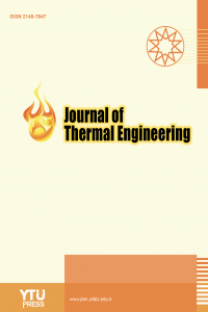THERMODYNAMIC PERFORMANCE ANALYSIS OF GAS LIQUEFACTION CYCLES FOR CRYOGENIC APPLICATIONS
In this paper presents an analysis of the thermodynamic cycles the
most commonly used for the liquefaction of gases in order to evaluate and
compare their performance under given working conditions and system component
efficiencies. The cycles considered are simple Linde-Hampson cycle, precooled
Linde-Hampson cycle, Claude cycle, and Kapitza cycle. First and second law
relations are investigated for each cycle and performance parameters are
evaluated. Thermodynamically performances criteria are compared of cycles with
respect to the each other. Cycles are model in the computer environment and
analyzed with Engineering Equation Solver (EES) software program. Cycles of the
liquefaction fractions, coefficient of performances and second law of
efficiencies are calculated for the liquefaction of different gases. Second law
efficiencies are calculated as 13.4%, 21.8%, 62.9%, and 77.2% for simple
Linde-Hampson cycle, pre-cooled Linde-Hampson cycle, Claude cycle, and Kapitza
cycle, respectively. Claude and Kapitza cycles give better performance but
simple and precooled Linde-Hampson cycle has the advantages of the simplicity
of their setup.
Keywords:
Cryogenic Cycles, Linde-Hampson Claude, Kapitza, J-T Expansion, Thermodynamic Analysis,
___
- [1] Kanoglu, M. (2002). Exergy analysis of multistage cascade refrigeration cycle used for natural gas liquefaction. International Journal of Energy Research, 26(8), 763-774.
- [2] Krasae-in, S., Stang, J. H., & Neksa, P. (2010). Development of large-scale hydrogen liquefaction processes from 1898 to 2009. International Journal of Hydrogen Energy, 35(10), 4524-4533.
- [3] Flynn, T. (2004). Cryogenic Engineering, revised and expanded. CRC Press.
- [4] Thomas, R. J., Ghosh, P., & Chowdhury, K. (2011). Exergy analysis of helium liquefaction systems based on modified Claude cycle with two-expanders. Cryogenics, 51(6), 287-294.
- [5] Atrey, M. D. (1998). Thermodynamic analysis of Collins helium liquefaction cycle. Cryogenics, 38(12), 1199-1206.
- [6] Wang, M., Khalilpour, R., & Abbas, A. (2014). Thermodynamic and economic optimization of LNG mixed refrigerant processes. Energy Conversion and Management, 88, 947-961.
- [7] Mehrpooya, M., & Ansarinasab, H. (2015). Exergoeconomic evaluation of single mixed refrigerant natural gas liquefaction processes. Energy Conversion and Management, 99, 400-413.
- [8] Bisht, V. S. Thermodynamic Analysis of Kapitza Cycle based on Nitrogen Liquefaction. IOSR Journal of Engineering (IOSRJEN). Vol. 04, Issue 05 (May. 2014), ||V6|| PP 38-44.
- [9] Barron, R. F. (1999). Cryogenic Heat Transfer (Vol. 1). Philadelphia, PA: Taylor & Francis.
- [10] Timmerhaus, K. D., & Flynn, T. M. (1989). Properties of solids. In Cryogenic Process Engineering (pp. 39-102). Springer US.
- [11] Maytal, B. Z. (2006). Maximizing production rates of the Linde–Hampson machine. Cryogenics, 46(1), 49-54.
- [12] Nandi, T. K., & Sarangi, S. (1993). Performance and optimization of hydrogen liquefaction cycles. International Journal of Hydrogen Energy, 18(2), 131-139.
- [13] Hilal, M. A. (1979). Optimization of helium refrigerators and liquefiers for large superconducting systems. Cryogenics, 19(7), 415-420.
- [14] Kanoglu, M., Dincer, I., & Rosen, M. A. (2008). Performance analysis of gas liquefaction cycles. International Journal of Energy Research, 32(1), 35-43.
- [15] Rashidi M.M., Aghagoli A., Raoofi R. (2017). Thermodynamic analysis of the ejector refrigeration cycle using the artificial neural network. Energy 129, 201- 215.
- [16] Habibzadeh A., Rashidi M.M., Galanis N. (2013). Analysis of a combined power and ejector-refrigeration cycle using low temperature heat. Energy Conversion and Management 65, 381- 391.
- [17] Kanoğlu, M. (2001). Cryogenic turbine efficiencies. Exergy, An International Journal, 1(3), 202-208.
- Yayın Aralığı: 6
- Başlangıç: 2015
- Yayıncı: YILDIZ TEKNİK ÜNİVERSİTESİ
